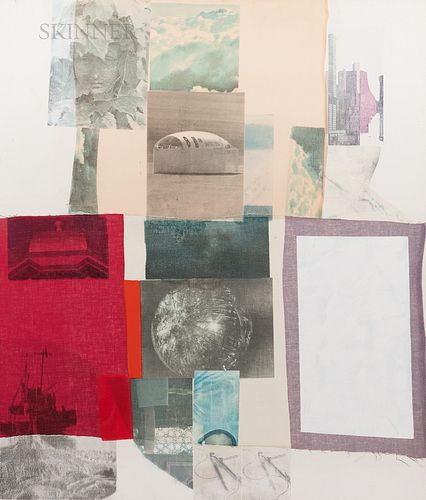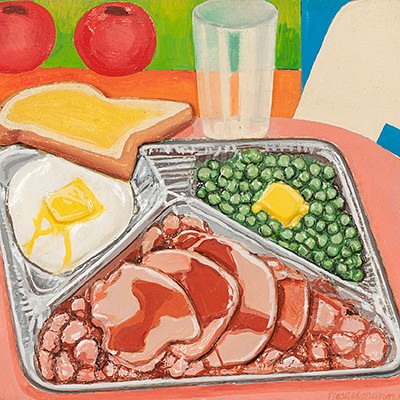Robert Rauschenberg (American, 1925-2008), Van Vleck Series III
Lot 61
About Seller
Bonhams Skinner
274 Cedar Hill Street
Marlborough, MA 01752
United States
Founded over four decades ago, Bonhams Skinner offers more than 60 auctions annually. Bonhams Skinner auctions reach an international audience and showcase the unique, rare, and beautiful in dozens of categories, including the fine and decorative arts, jewelry, modern design, musical instruments, sc...Read more
Categories
Estimate:
$60,000 - $80,000
Absentee vs Live bid
Two ways to bid:
- Leave a max absentee bid and the platform will bid on your behalf up to your maximum bid during the live auction.
- Bid live during the auction and your bids will be submitted real-time to the auctioneer.
Bid Increments
| Price | Bid Increment |
|---|---|
| $0 | $10 |
| $100 | $25 |
| $500 | $50 |
| $1,000 | $100 |
| $3,000 | $250 |
| $5,000 | $500 |
| $10,000 | $1,000 |
| $30,000 | $2,500 |
| $50,000 | $5,000 |
| $100,000 | $10,000 |
| $300,000 | $25,000 |
| $500,000 | $50,000 |
| $1,000,000 | $100,000 |
About Auction
By Bonhams Skinner
Jun 29, 2022
Set Reminder
2022-06-29 10:00:00
2022-06-29 10:00:00
America/New_York
Bidsquare
Bidsquare : Modern & Contemporary Art
https://www.bidsquare.com/auctions/skinner/modern-contemporary-art-9516
Join us in our Marlborough gallery on June 29th at 10AM for this live auction of Modern & Contemporary Works of Art, including paintings, sculpture, and works on paper from the 20th and 21st centuries. Items range from a Yayoi Kusama Pumpkin multiple to a Robert Rauschenberg portrait. Bonhams Skinner bidsquare@bonhamsskinner.com
Join us in our Marlborough gallery on June 29th at 10AM for this live auction of Modern & Contemporary Works of Art, including paintings, sculpture, and works on paper from the 20th and 21st centuries. Items range from a Yayoi Kusama Pumpkin multiple to a Robert Rauschenberg portrait. Bonhams Skinner bidsquare@bonhamsskinner.com
- Lot Description
Robert Rauschenberg (American, 1925-2008)
Van Vleck Series III
Titled, signed, and dated ".../RAUSCHENBERG 78" on the reverse.
Solvent transfer, fabric, and acrylic on plywood, 42 x 36 in. (106.7 x 91.4 cm), framed.
Condition: Scattered accretions and abrasions, surface grime.
Provenance: Commissioned from the artist by Joseph Van Vleck, Jr., Captiva, Florida; by family descent to the current private collection, Connecticut.
Exhibitions: Robert Rauschenberg: Two Serial Works, Montclair Art Museum, New Jersey, Jan. 13-March 3, 1980; Robert Rauschenberg: Eight Paintings, The Newark Museum, New Jersey, April 26-June 8, 1980; Robert Rauschenberg: The Van Vleck Series, I-VIII, Nelson-Atkins Museum, Kansas City (April 9-May 30, 1982), University of Iowa Museum of Art, Iowa City (June 15-Aug. 29, 1982), Phoenix Art Museum (August 29-October 12, 1982), Utah Museum of Fine Arts, Salt Lake City (January 9-Feb. 13, 1983).
N.B. Rauschenberg created a group of eight wooden panels in exchange for a property in Captiva Island, Florida, owned by Joseph Van Vleck. Van Vleck and his wife, Louise, along with Van Vleck's six children from previous marriages, resided on an adjacent property, and Rauschenberg conceived each panel as a representation of a different member of the family. Contemporaneous with Rauschenberg's Spreads series (1975-83) and sharing similar techniques and materials with those larger-scale works, the Van Vleck Series paintings originally hung together in a continuous installation as intended by the artist; however, each panel serves as an individual portrait, and Van Vleck gifted each child his or hers. This example includes imagery transferred and/or collaged from publications and magazines including Sports Illustrated.
Rauschenberg first experimented with solvent transfer (transferring media images to paper supports) in 1952, before fully developing the technique in 1958. This work, from 1978, shows Rauschenberg’s mature development of the technique, when he no longer used it exclusively for works on paper. After moistening print media with solvent, Rauschenberg placed the image or text face down and used pressure to transfer the ink. In this case, Rauschenberg used a press to apply even pressure to the transfers.
Joseph Van Vleck, in a letter dated Sept. 25, 1979, wrote about the paintings: "I think what Rauschenberg is doing in each of the eight paintings is to assemble images helping the observer to think of his own life, other forms of life, —yes, and non-life—which surround him. And also to think of movement or travel, work and play, and other forms of activity in a full life. We sense the artist’s ideas of what attracts human attention and sometimes holds it, influencing attitudes and behavior.... Imperfections appear in the use of solvent transfer of images. At first, I was critical—why, I asked, does such an able artist tolerate such vague images? Then. I thought of the many things during my life that I have only half seen. And I thought of what I once knew well, and now cannot recall. Blurred images disturb me no longer!"
Rauschenberg, in a handwritten statement about the series dated March 11, 1981, wrote: "I thought of the commissioned series of collage paintings that I made for the Van Vleck Family as a group of abstract portraits each with the family unification and restrictions and each with the uniquness [sic] and couriosity [sic] of the chosen individual in the choosing. With the radical differences hopefully and the blood calm as security each subject would have to recognize his own likeness, and maybe change." (Robert Rauschenberg papers. Robert Rauschenberg Foundation Archives, New York.)
We would like to thank the Robert Rauschenberg Foundation for their kind assistance in cataloguing this work.Condition
Condition: Framed dimensions: 43 1/4 x 37 in.
Any condition statement is given as a courtesy to a client, is only an opinion and should not be treated as a statement of fact. Skinner Inc. shall have no responsibility for any error or omission. The absence of a condition statement does not imply that the lot is in perfect condition or completely free from wear and tear, imperfections or the effects of aging. - Shipping Info
-
Please visit http://www.skinnerinc.com/services/payment-and-shipping/ for information regarding the collection of items purchased at auction.
-
- Buyer's Premium



 EUR
EUR CAD
CAD AUD
AUD GBP
GBP MXN
MXN HKD
HKD CNY
CNY MYR
MYR SEK
SEK SGD
SGD CHF
CHF THB
THB














